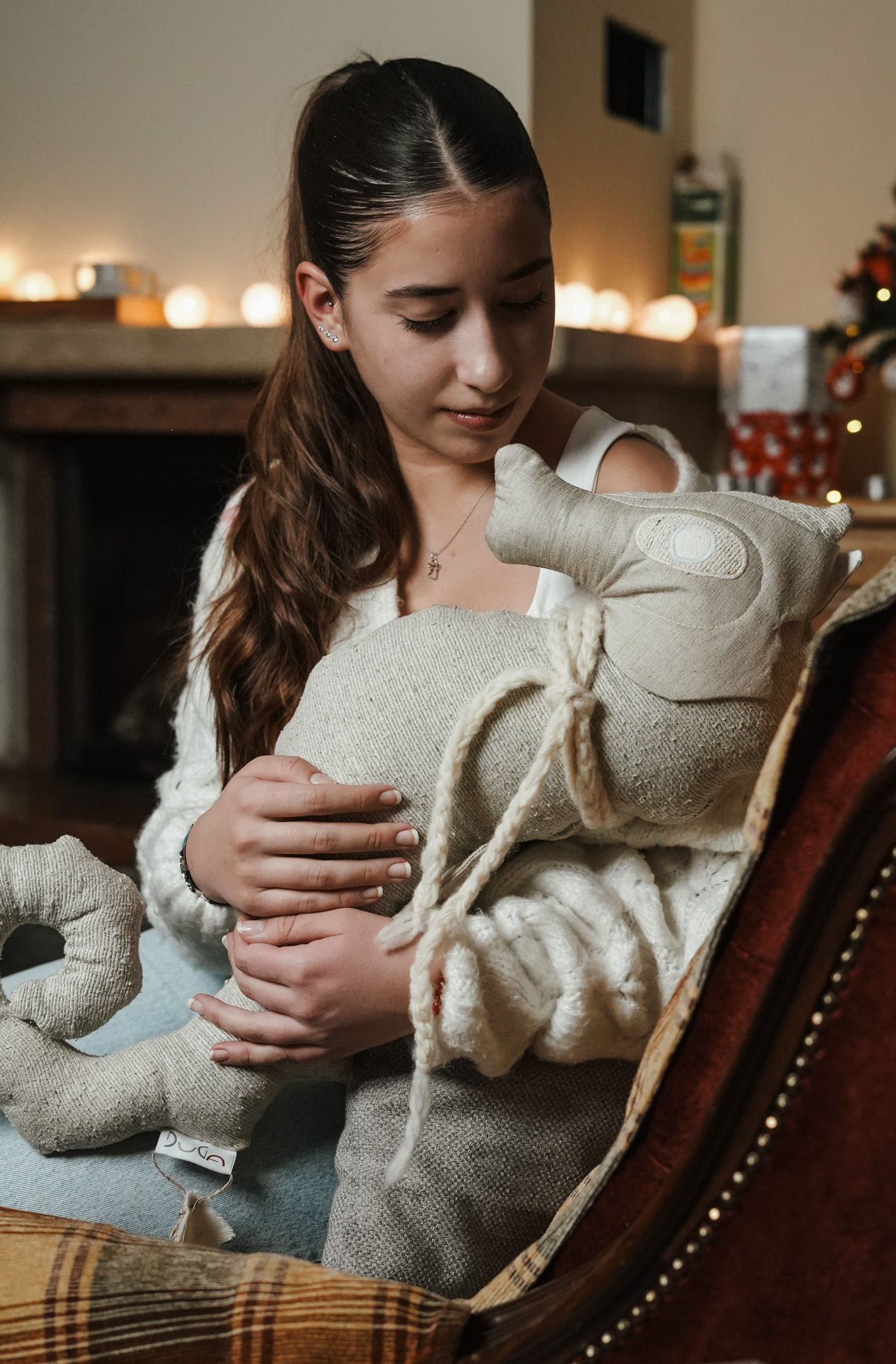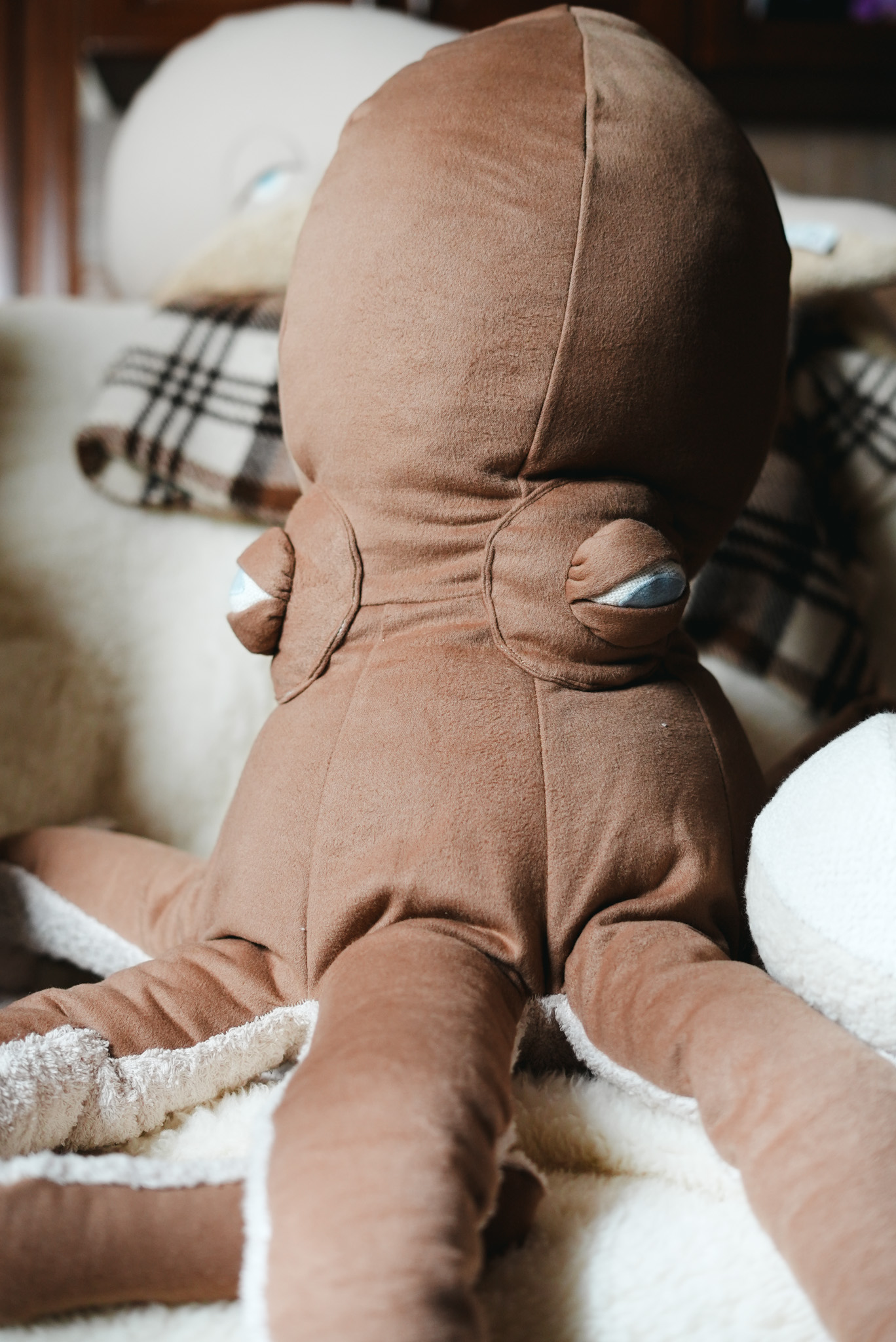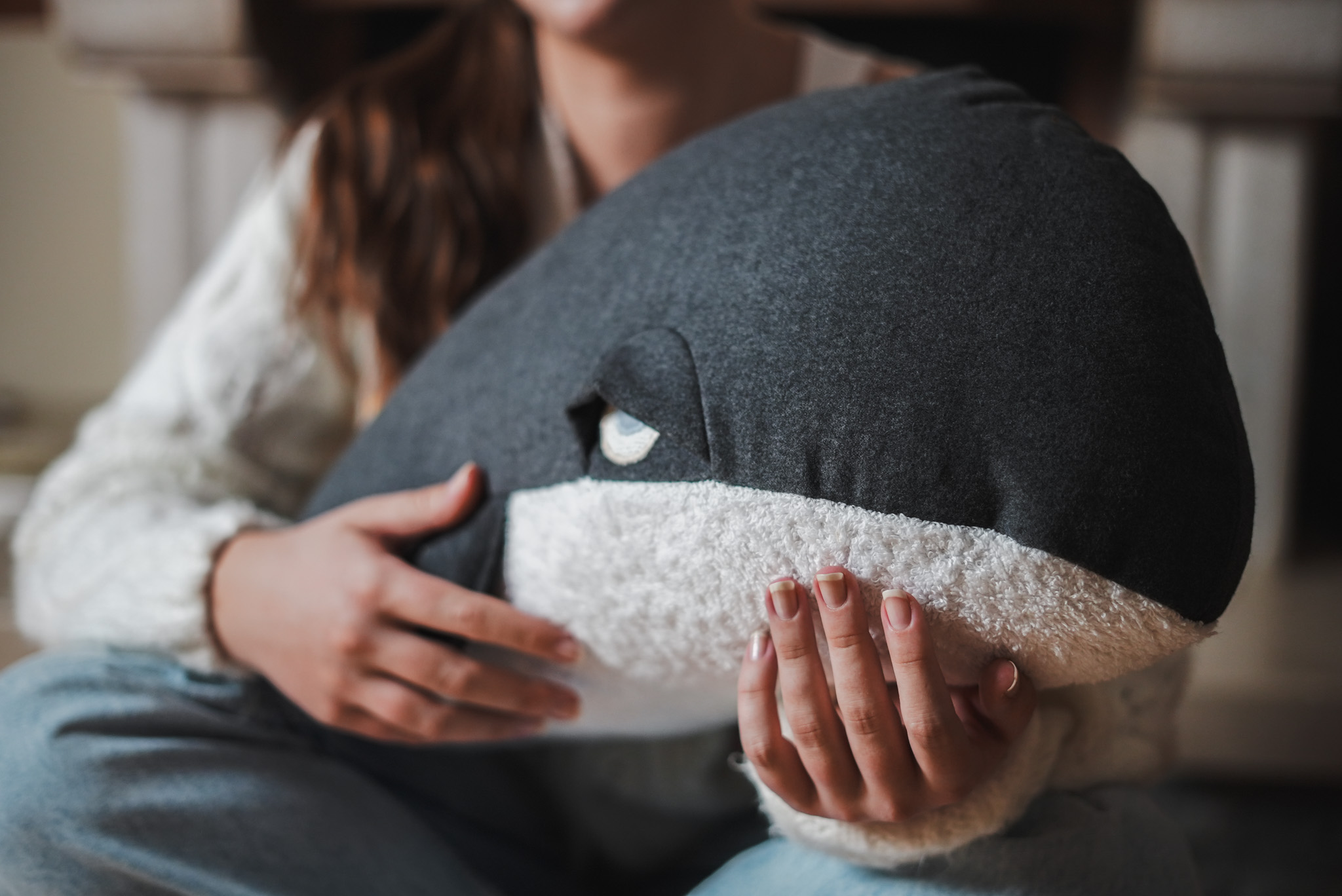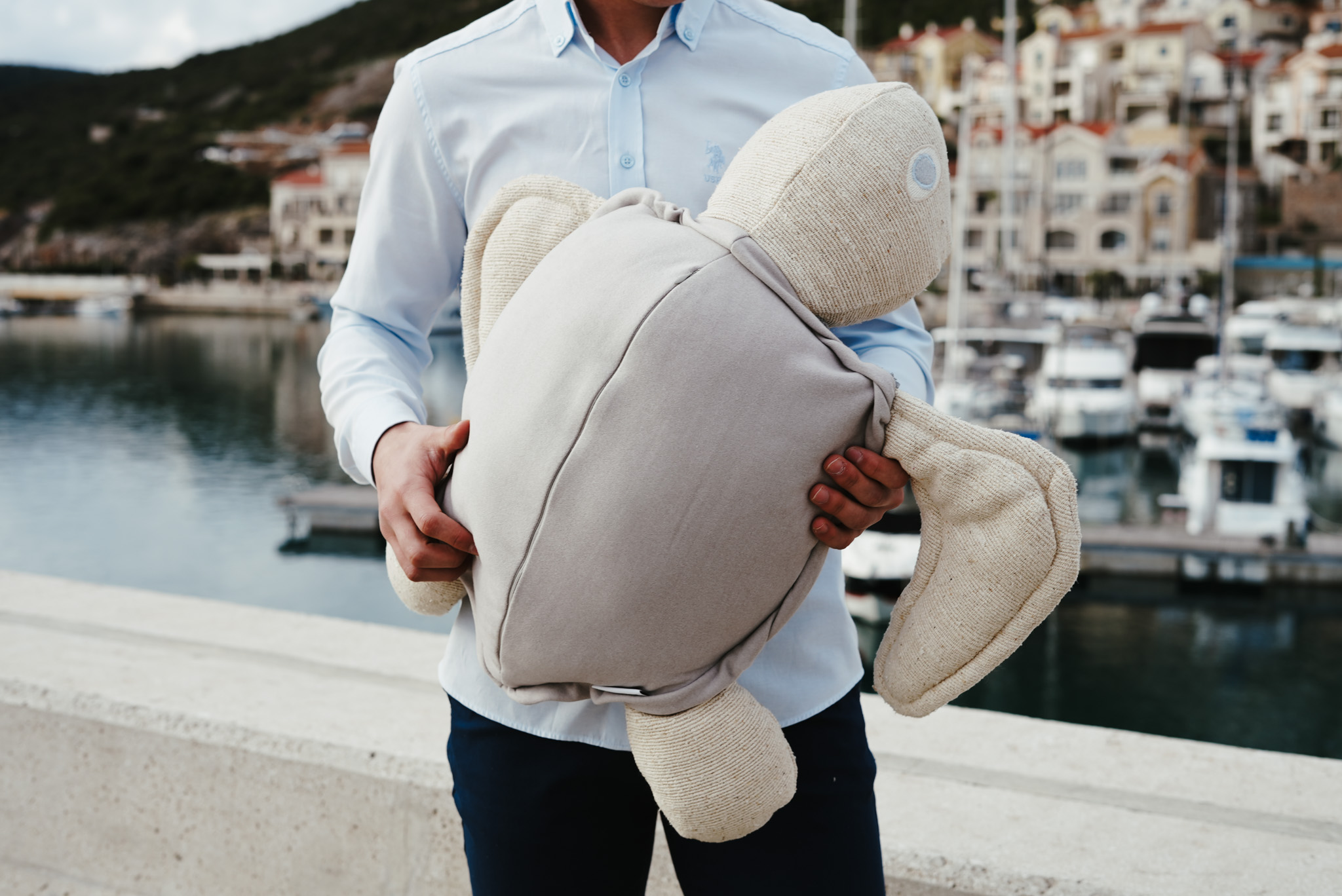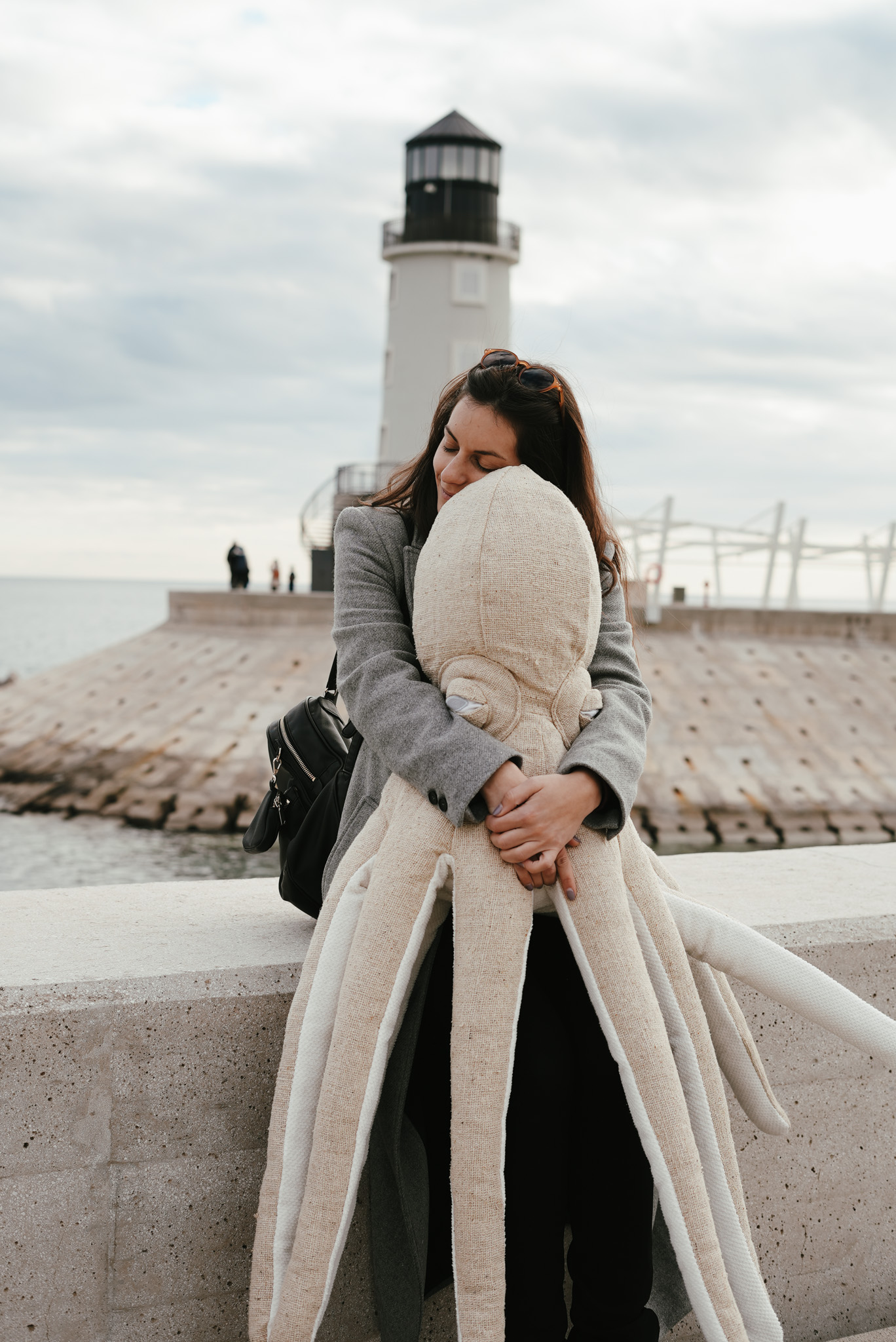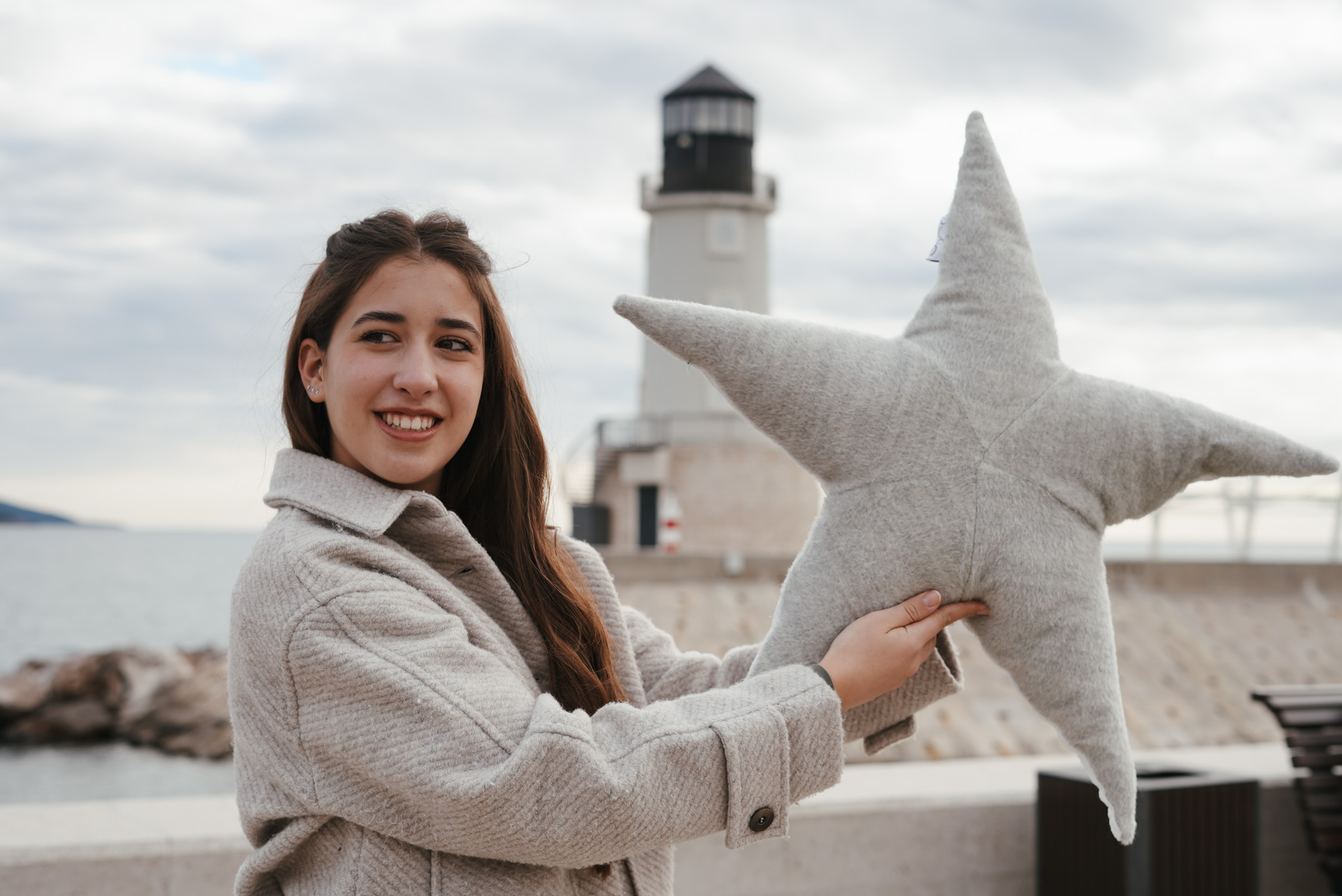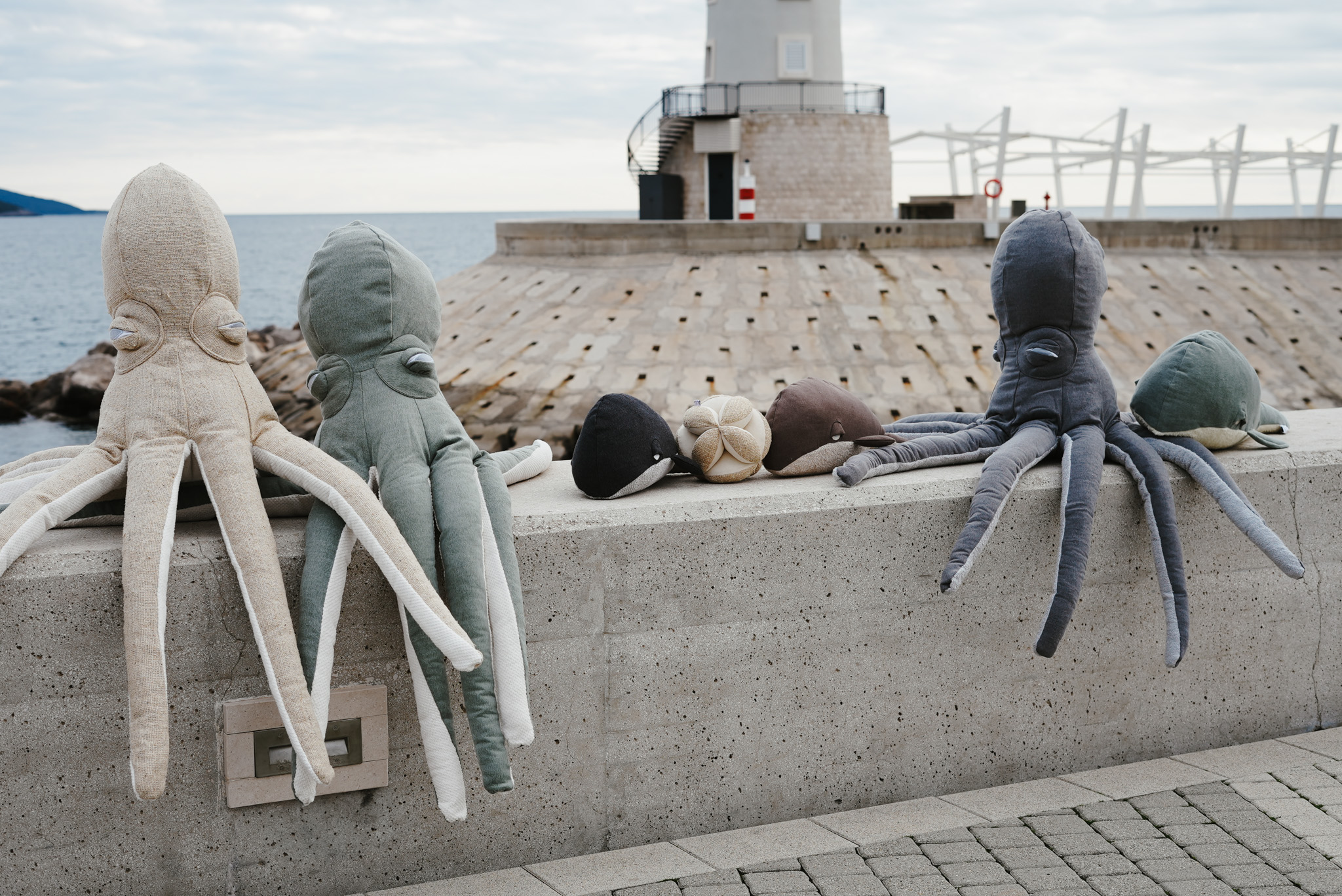Shaping a circular industrial ecosystem and supporting life-cycle thinking
Duga Toys
Duga Toys
Duga Toys: Play with Purpose
Duga Toys creates handmade sea animal plushies to teach kids about ocean conservation. Made from natural, sustainable materials, our toys are safe, washable, and designed to last for generations. Every piece of fabric is used—leftovers become play mats, Montessori balls, or eco-friendly seating. With soft colors and thoughtful design, Duga Toys inspires love for nature through play.
Duga Toys creates handmade sea animal plushies to teach kids about ocean conservation. Made from natural, sustainable materials, our toys are safe, washable, and designed to last for generations. Every piece of fabric is used—leftovers become play mats, Montessori balls, or eco-friendly seating. With soft colors and thoughtful design, Duga Toys inspires love for nature through play.
Montenegro
National
It addresses urban-rural linkages
It refers to other types of transformations (soft investment)
Yes
2021-06-24
No
No
No
As a representative of an organisation
Duga Toys: Play, Learn, and Protect
Duga Toys embodies the core values of the New European Bauhaus—sustainability, aesthetics, and inclusion—through the creation of handmade plush toys inspired by marine life. Our mission is to introduce children to the beauty of nature, fostering early environmental awareness and responsibility while promoting sustainable production practices.
We prioritize circular design by using only natural, biodegradable materials such as cotton, wool, bourette silk, and linen. Every toy is made to last—washable, repairable, and designed for intergenerational use. We minimize waste by repurposing fabric scraps into play mats, Montessori balls, and seating cushions, ensuring that every piece of material finds a purpose. Additionally, our reusable cotton bags replace plastic packaging, reducing environmental impact.
Inspired by the soothing colors of coastal landscapes, Duga Toys feature natural, soft tones that are visually calming and promote sensory harmony. The combination of textures—from raw silk to coarser linen—enhances children’s tactile development while creating a connection between design and nature.
Our toys are designed to be safe, accessible, and educational for all children. With securely stitched details and diverse textures, they encourage motor skill development and sensory exploration. By making sustainable play available to families, we inspire a collective responsibility toward protecting our planet.
By integrating sustainability, aestetics, and inclusion into our work, Duga Toys transforms playtime into an opportunity to connect with nature, appreciate thoughtful design, and embrace a sustainable way of living.
Duga Toys embodies the core values of the New European Bauhaus—sustainability, aesthetics, and inclusion—through the creation of handmade plush toys inspired by marine life. Our mission is to introduce children to the beauty of nature, fostering early environmental awareness and responsibility while promoting sustainable production practices.
We prioritize circular design by using only natural, biodegradable materials such as cotton, wool, bourette silk, and linen. Every toy is made to last—washable, repairable, and designed for intergenerational use. We minimize waste by repurposing fabric scraps into play mats, Montessori balls, and seating cushions, ensuring that every piece of material finds a purpose. Additionally, our reusable cotton bags replace plastic packaging, reducing environmental impact.
Inspired by the soothing colors of coastal landscapes, Duga Toys feature natural, soft tones that are visually calming and promote sensory harmony. The combination of textures—from raw silk to coarser linen—enhances children’s tactile development while creating a connection between design and nature.
Our toys are designed to be safe, accessible, and educational for all children. With securely stitched details and diverse textures, they encourage motor skill development and sensory exploration. By making sustainable play available to families, we inspire a collective responsibility toward protecting our planet.
By integrating sustainability, aestetics, and inclusion into our work, Duga Toys transforms playtime into an opportunity to connect with nature, appreciate thoughtful design, and embrace a sustainable way of living.
Nature-inspired design
Eco-friendly materials
Education and sensory play
Environmental awareness
Water protection
Duga Toys is committed to promoting sustainability through eco-friendly materials, circular design, and environmental education. Our key objectives align with the principles of responsible production and consumption, reducing waste, and raising awareness about the importance of water protection and marine conservation.
Sustainable Materials
We use only natural, biodegradable fabrics such as cotton, wool, silk, and linen, avoiding synthetic materials that contribute to pollution.
Each toy is designed for durability—they are washable, repairable, and meant to be passed down through generations, reducing fast-consumption culture.
Fabric scraps are repurposed into play mats, Montessori balls, and seating cushions, ensuring a zero-waste production process.
Eliminating Plastic & Reducing Waste
Instead of plastic packaging, every toy comes in a reusable cotton bag that can serve multiple purposes, promoting sustainable habits.
By focusing on handmade, small-batch production, we minimize excess inventory and waste, ensuring thoughtful resource use.
Water Protection & Marine Conservation Awareness
By crafting sea-animal-inspired toys, we educate children about marine life and the importance of keeping waters clean.
Through storytelling and play, we encourage children to adopt environmentally responsible behaviors, such as reducing waste and respecting natural habitats.
A Model for Sustainable Design
Duga Toys demonstrates how traditional craftsmanship, ecological responsibility, and education can come together to create a product that is both beautiful and impactful. By integrating sustainability into every step—from material sourcing to design and packaging—we set an example of how small businesses can drive positive environmental change. Additional contribution is the fact that Duga Toys in still the only small business creating products in the above mentioned way which was recognized by the community and institutions (certificates attached).
Sustainable Materials
We use only natural, biodegradable fabrics such as cotton, wool, silk, and linen, avoiding synthetic materials that contribute to pollution.
Each toy is designed for durability—they are washable, repairable, and meant to be passed down through generations, reducing fast-consumption culture.
Fabric scraps are repurposed into play mats, Montessori balls, and seating cushions, ensuring a zero-waste production process.
Eliminating Plastic & Reducing Waste
Instead of plastic packaging, every toy comes in a reusable cotton bag that can serve multiple purposes, promoting sustainable habits.
By focusing on handmade, small-batch production, we minimize excess inventory and waste, ensuring thoughtful resource use.
Water Protection & Marine Conservation Awareness
By crafting sea-animal-inspired toys, we educate children about marine life and the importance of keeping waters clean.
Through storytelling and play, we encourage children to adopt environmentally responsible behaviors, such as reducing waste and respecting natural habitats.
A Model for Sustainable Design
Duga Toys demonstrates how traditional craftsmanship, ecological responsibility, and education can come together to create a product that is both beautiful and impactful. By integrating sustainability into every step—from material sourcing to design and packaging—we set an example of how small businesses can drive positive environmental change. Additional contribution is the fact that Duga Toys in still the only small business creating products in the above mentioned way which was recognized by the community and institutions (certificates attached).
Duga Toys merges design, sensory experience, and cultural values to create sustainable, visually appealing, and educational toys. Our approach ensures that playtime is not only engaging but also enriches children’s connection with nature, fostering appreciation for craftsmanship and environmental responsibility.
Nature-Inspired, Calming Aesthetic
Our designs reflect the soft, natural tones of coastal landscapes—beige, blue, and earth hues—avoiding overstimulating colors to create a soothing, harmonious visual experience. The tactile experience is carefully curated through a mix of textures— raw silk, soft wool, and structured linen—encouraging children’s sensory and motor development.
Thoughtful, High-Quality Craftsmanship
Each toy is handmade with precision, ensuring durability, safety, and attention to detail. Features such as stitched and embroidered details eliminate small detachable parts, making them safe for all ages. Washable and repairable, the toys are designed for long-term use and intergenerational play, countering the disposable culture of mass production.
Cultural & Educational Value
Inspired by marine life, the toys introduce children to biodiversity and environmental awareness through storytelling and imaginative play. Each piece is a tribute to traditional craftsmanship, promoting an appreciation for handmade, sustainable goods over fast-production alternatives.
A Model for Sustainable & Meaningful Design
Duga Toys exemplifies how aesthetic beauty, sensory experience, and cultural storytelling can be integrated into sustainable product design. By prioritizing natural materials, craftsmanship, and eco-conscious principles, we create toys that are not only enjoyable but also shape a more thoughtful and responsible future for young generations.
Nature-Inspired, Calming Aesthetic
Our designs reflect the soft, natural tones of coastal landscapes—beige, blue, and earth hues—avoiding overstimulating colors to create a soothing, harmonious visual experience. The tactile experience is carefully curated through a mix of textures— raw silk, soft wool, and structured linen—encouraging children’s sensory and motor development.
Thoughtful, High-Quality Craftsmanship
Each toy is handmade with precision, ensuring durability, safety, and attention to detail. Features such as stitched and embroidered details eliminate small detachable parts, making them safe for all ages. Washable and repairable, the toys are designed for long-term use and intergenerational play, countering the disposable culture of mass production.
Cultural & Educational Value
Inspired by marine life, the toys introduce children to biodiversity and environmental awareness through storytelling and imaginative play. Each piece is a tribute to traditional craftsmanship, promoting an appreciation for handmade, sustainable goods over fast-production alternatives.
A Model for Sustainable & Meaningful Design
Duga Toys exemplifies how aesthetic beauty, sensory experience, and cultural storytelling can be integrated into sustainable product design. By prioritizing natural materials, craftsmanship, and eco-conscious principles, we create toys that are not only enjoyable but also shape a more thoughtful and responsible future for young generations.
Duga Toys is built on the principle that sustainability, education, and quality play experiences should be accessible to all children, regardless of background. Our approach to inclusion is reflected in affordability, safety, sensory-friendly design, and community-driven production, ensuring that our toys are both environmentally and socially responsible.
Accessible & Safe Design for All
Our toys are designed with universal usability in mind—soft, durable, and free from small detachable parts, making them safe for children of all ages and abilities.
Different textures in each toy (raw silk, soft wool, coarser linen) support sensory development, making them suitable for children with sensory sensitivities or special needs.
Affordability & Responsible Consumption
By ensuring that each toy is washable, repairable, and designed to last for generations, we promote long-term value over disposable consumerism, making sustainable toys a smart investment for families. We reduce production costs by eliminating plastic packaging and using every scrap of material, allowing us to offer handmade, high-quality toys at a fair price.
Community-Driven & Ethical Production
We collaborate with local suppliers and artisans, ensuring that our materials are ethically sourced and supporting small-scale, sustainable businesses. By promoting traditional craftsmanship and responsible labor practices, we create an alternative to mass production that values both people and the environment.
A Model for Inclusive & Sustainable Play
Duga Toys demonstrates how design, sustainability, and social responsibility can come together to create products that are inclusive, ethical, and accessible. By prioritizing safety, affordability, and long-term usability, we make sustainable, educational play available to all children, inspiring a new generation to care for both people and the planet.
Accessible & Safe Design for All
Our toys are designed with universal usability in mind—soft, durable, and free from small detachable parts, making them safe for children of all ages and abilities.
Different textures in each toy (raw silk, soft wool, coarser linen) support sensory development, making them suitable for children with sensory sensitivities or special needs.
Affordability & Responsible Consumption
By ensuring that each toy is washable, repairable, and designed to last for generations, we promote long-term value over disposable consumerism, making sustainable toys a smart investment for families. We reduce production costs by eliminating plastic packaging and using every scrap of material, allowing us to offer handmade, high-quality toys at a fair price.
Community-Driven & Ethical Production
We collaborate with local suppliers and artisans, ensuring that our materials are ethically sourced and supporting small-scale, sustainable businesses. By promoting traditional craftsmanship and responsible labor practices, we create an alternative to mass production that values both people and the environment.
A Model for Inclusive & Sustainable Play
Duga Toys demonstrates how design, sustainability, and social responsibility can come together to create products that are inclusive, ethical, and accessible. By prioritizing safety, affordability, and long-term usability, we make sustainable, educational play available to all children, inspiring a new generation to care for both people and the planet.
Our project is deeply intertwined with collaboration, feedback, and active involvement from both consumers and local artisans, ensuring that the impact of our toys extends beyond just the product itself.
We partner with local artisans and small-scale suppliers to source high-quality natural materials. This collaboration ensures that we support local economies and reduce our carbon footprint by sourcing materials from nearby, sustainable producers. Citizens involved in production benefit from fair labor practices, ethical working conditions, and the preservation of traditional craftsmanship. By working directly with small businesses, we ensure that the values of sustainability and ethics are upheld throughout the supply chain.
Our local suppliers and artisans provide invaluable feedback on the quality and sustainability of the materials, enabling us to continuously improve the product while staying true to our sustainable goals.
We actively engage with our customers, especially families, to understand their needs and expectations. Through direct conversations, social media, and feedback channels, we receive valuable insights on how our toys impact children’s sensory development and their connection to environmental awareness.
By involving parents in this process, we create a community of like-minded individuals who are passionate about sustainability, education, and quality play. This feedback loop has led to product improvements and the development of new ideas, such as the potential future use of wool from local farmers for toy filling. We also host workshops and educational events where children and families can engage with our toys, learn about marine conservation, and explore eco-friendly alternatives. These initiatives foster active participation in sustainability efforts. This collaborative approach has not only helped us stay true to our values but has also amplified the project’s impact, creating a ripple effect that extends to the broader community.
We partner with local artisans and small-scale suppliers to source high-quality natural materials. This collaboration ensures that we support local economies and reduce our carbon footprint by sourcing materials from nearby, sustainable producers. Citizens involved in production benefit from fair labor practices, ethical working conditions, and the preservation of traditional craftsmanship. By working directly with small businesses, we ensure that the values of sustainability and ethics are upheld throughout the supply chain.
Our local suppliers and artisans provide invaluable feedback on the quality and sustainability of the materials, enabling us to continuously improve the product while staying true to our sustainable goals.
We actively engage with our customers, especially families, to understand their needs and expectations. Through direct conversations, social media, and feedback channels, we receive valuable insights on how our toys impact children’s sensory development and their connection to environmental awareness.
By involving parents in this process, we create a community of like-minded individuals who are passionate about sustainability, education, and quality play. This feedback loop has led to product improvements and the development of new ideas, such as the potential future use of wool from local farmers for toy filling. We also host workshops and educational events where children and families can engage with our toys, learn about marine conservation, and explore eco-friendly alternatives. These initiatives foster active participation in sustainability efforts. This collaborative approach has not only helped us stay true to our values but has also amplified the project’s impact, creating a ripple effect that extends to the broader community.
The design is the idea of the Duga Toys team based on suggestions of the community. Parents and teachers provided feedback on the educational and sensory aspects of the toys, ensuring they meet children's developmental needs. Most importantly, children provided us with feedback - we very much rely on their suggestions since the sustainability and future of our community in their hands.
National media in Montenegro featured the project's impact and innovation, broadening its reach and enhancing the project's awareness campaigns and community engagement.
One example at page 96 (English version available) https://caffemontenegro.me/casopis/broj-223
Additionally, we were supported by the Capital City Podgorica with 2000 EUR for innovation and sustainability.
The collaborative process between different stakeholders enriched Duga Toys' design, production, and impact. The Duga Toys team developed the concept based on community input, ensuring the toys aligned with both environmental and educational goals. Parents and teachers played a key role by providing feedback on how the toys could best support children’s sensory development and learning, helping refine their textures, shapes, and durability.
The interaction between these different fields—design, education, media, and policy support—created a holistic approach that strengthened the project’s sustainability, educational value, and visibility. The added value of this process was the creation of a well-rounded, community-driven initiative that is not only environmentally friendly but also beneficial for children's development and widely recognized for its impact.
National media in Montenegro featured the project's impact and innovation, broadening its reach and enhancing the project's awareness campaigns and community engagement.
One example at page 96 (English version available) https://caffemontenegro.me/casopis/broj-223
Additionally, we were supported by the Capital City Podgorica with 2000 EUR for innovation and sustainability.
The collaborative process between different stakeholders enriched Duga Toys' design, production, and impact. The Duga Toys team developed the concept based on community input, ensuring the toys aligned with both environmental and educational goals. Parents and teachers played a key role by providing feedback on how the toys could best support children’s sensory development and learning, helping refine their textures, shapes, and durability.
The interaction between these different fields—design, education, media, and policy support—created a holistic approach that strengthened the project’s sustainability, educational value, and visibility. The added value of this process was the creation of a well-rounded, community-driven initiative that is not only environmentally friendly but also beneficial for children's development and widely recognized for its impact.
Duga Toys integrates multiple disciplines to create sustainable, educational, and socially impactful toys.
Sustainable Design & Materials Science: The project prioritizes eco-friendly materials like cotton, wool, and silk, guided by experts in sustainable design and material science. Collaboration between designers and material scientists ensures durability, safety, and minimal environmental impact. Additionally, zero-waste strategies were implemented by repurposing fabric scraps.
Craftsmanship & Traditional Artisanal Skills: Local artisans and craftspeople apply traditional skills, ensuring high-quality, handcrafted toys. This partnership blends modern sustainability practices with cultural craftsmanship, preserving valuable skills while minimizing waste and maximizing durability.
Educational Theory & Child Development: Input from educational specialists ensures the toys support sensory and motor development, with a focus on environmental awareness. The toys’ textures and design encourage tactile exploration and instill empathy for marine life and nature.
Environmental Science & Marine Conservation: Environmental experts shaped the project's theme around marine conservation, raising awareness of ocean pollution and water protection. The toys are designed to foster a connection with the natural world and inspire eco-consciousness in children.
Business & Social Innovation: Social entrepreneurs and business strategists ensure the project remains economically viable while promoting social impact. They balanced pricing with sustainable production practices, helping to make high-quality, eco-conscious toys accessible while maintaining ethical supply chains.
The interdisciplinary collaboration between these fields has added significant value by ensuring the project is holistic and impactful. Duga Toys is not just a product—it’s an educational tool, a work of art, and a statement of sustainability.
Sustainable Design & Materials Science: The project prioritizes eco-friendly materials like cotton, wool, and silk, guided by experts in sustainable design and material science. Collaboration between designers and material scientists ensures durability, safety, and minimal environmental impact. Additionally, zero-waste strategies were implemented by repurposing fabric scraps.
Craftsmanship & Traditional Artisanal Skills: Local artisans and craftspeople apply traditional skills, ensuring high-quality, handcrafted toys. This partnership blends modern sustainability practices with cultural craftsmanship, preserving valuable skills while minimizing waste and maximizing durability.
Educational Theory & Child Development: Input from educational specialists ensures the toys support sensory and motor development, with a focus on environmental awareness. The toys’ textures and design encourage tactile exploration and instill empathy for marine life and nature.
Environmental Science & Marine Conservation: Environmental experts shaped the project's theme around marine conservation, raising awareness of ocean pollution and water protection. The toys are designed to foster a connection with the natural world and inspire eco-consciousness in children.
Business & Social Innovation: Social entrepreneurs and business strategists ensure the project remains economically viable while promoting social impact. They balanced pricing with sustainable production practices, helping to make high-quality, eco-conscious toys accessible while maintaining ethical supply chains.
The interdisciplinary collaboration between these fields has added significant value by ensuring the project is holistic and impactful. Duga Toys is not just a product—it’s an educational tool, a work of art, and a statement of sustainability.
The innovative character of Duga Toys:
Sustainability Beyond Materials
While many toy manufacturers are shifting toward eco-friendly materials, Duga Toys goes a step further by embracing a zero-waste approach. Leftover materials are turned into play mats, educational items, or small accessories, ensuring that nothing is wasted, while other companies often dispose of production scraps. Even declarations are made and hand-crafted of recycled natural materials.
Design for Multiple Generations
Unlike typical toys, which are often designed to be disposable after a short period, Duga Toys are intentionally built to last for generations. The materials and design allow for repair, washing, and reusing. The toys can be passed down through generations, a contrast to the fast-paced, throwaway culture in the toy industry.
Multidimensional Educational Approach
Duga Toys not only engage children in sensory play but also integrate environmental education through their designs. Each toy has a marine life theme, promoting ocean conservation, water protection, and the importance of clean ecosystems. The toys are designed to foster early childhood development through both tactile stimulation and educational storytelling, encouraging empathy for nature. This dual focus on play and education is rare in the toy industry, where entertainment often takes precedence over education.
Natural Materials & Local Production
Duga Toys uses a combination of natural fibers, such as raw cotton, wool, and silk, sourced from local artisans and suppliers. This locally focused production contrasts with the mass-produced, plastic-based toys dominating the market.
Ethical, Community-Centric Model
Instead of prioritizing large-scale, low-cost production, we actively involve local artisans, families, and educators in the design and feedback loop.
Sensory-Integrated Play
Each toy is designed to engage children’s sensory development, with varying textures for tactile exploration.
Sustainability Beyond Materials
While many toy manufacturers are shifting toward eco-friendly materials, Duga Toys goes a step further by embracing a zero-waste approach. Leftover materials are turned into play mats, educational items, or small accessories, ensuring that nothing is wasted, while other companies often dispose of production scraps. Even declarations are made and hand-crafted of recycled natural materials.
Design for Multiple Generations
Unlike typical toys, which are often designed to be disposable after a short period, Duga Toys are intentionally built to last for generations. The materials and design allow for repair, washing, and reusing. The toys can be passed down through generations, a contrast to the fast-paced, throwaway culture in the toy industry.
Multidimensional Educational Approach
Duga Toys not only engage children in sensory play but also integrate environmental education through their designs. Each toy has a marine life theme, promoting ocean conservation, water protection, and the importance of clean ecosystems. The toys are designed to foster early childhood development through both tactile stimulation and educational storytelling, encouraging empathy for nature. This dual focus on play and education is rare in the toy industry, where entertainment often takes precedence over education.
Natural Materials & Local Production
Duga Toys uses a combination of natural fibers, such as raw cotton, wool, and silk, sourced from local artisans and suppliers. This locally focused production contrasts with the mass-produced, plastic-based toys dominating the market.
Ethical, Community-Centric Model
Instead of prioritizing large-scale, low-cost production, we actively involve local artisans, families, and educators in the design and feedback loop.
Sensory-Integrated Play
Each toy is designed to engage children’s sensory development, with varying textures for tactile exploration.
The methodology behind Duga Toys is based on a holistic, interdisciplinary approach that integrates sustainable practices, educational principles, and craftsmanship. The project is designed to create a product that not only serves as a toy but also as an educational tool and environmental statement, promoting sustainability and responsible consumption. Here's a breakdown of the key elements of our approach:
1. Sustainable Design & Circular Economy
We prioritize the use of natural, biodegradable materials (like cotton, wool, silk, and jute) to ensure minimal environmental impact throughout the toy's lifecycle.
2. Community-Based Craftsmanship
The toys are crafted by local artisans who specialize in traditional sewing, embroidery, and fabric manipulation techniques.
3. Design for Education & Sensory Development
Duga Toys are designed with a strong focus on early childhood development and educational play. The toys are purposefully crafted to engage children's sensory development, with varying textures that encourage tactile exploration.
4. Feedback-Driven Iteration
Our design process is iterative and feedback-driven, ensuring the toys evolve in response to the needs of both children and parents. We actively seek feedback from families, educators, and environmental organizations to understand how the toys can better serve educational, developmental, and environmental goals.
5. Multi-Disciplinary Collaboration
We employ a collaborative methodology, involving experts from different fields.
6. Long-Term Vision - The materials, design, and construction methods are intended to ensure that the toys last for many years, allowing them to be passed down to future generations.
1. Sustainable Design & Circular Economy
We prioritize the use of natural, biodegradable materials (like cotton, wool, silk, and jute) to ensure minimal environmental impact throughout the toy's lifecycle.
2. Community-Based Craftsmanship
The toys are crafted by local artisans who specialize in traditional sewing, embroidery, and fabric manipulation techniques.
3. Design for Education & Sensory Development
Duga Toys are designed with a strong focus on early childhood development and educational play. The toys are purposefully crafted to engage children's sensory development, with varying textures that encourage tactile exploration.
4. Feedback-Driven Iteration
Our design process is iterative and feedback-driven, ensuring the toys evolve in response to the needs of both children and parents. We actively seek feedback from families, educators, and environmental organizations to understand how the toys can better serve educational, developmental, and environmental goals.
5. Multi-Disciplinary Collaboration
We employ a collaborative methodology, involving experts from different fields.
6. Long-Term Vision - The materials, design, and construction methods are intended to ensure that the toys last for many years, allowing them to be passed down to future generations.
Duga Toys’ methodology—centered around sustainability, local craftsmanship, educational value, and circular production—can be transferred to different regions and groups. By adapting the materials, production processes, and educational goals, the project’s core principles can benefit communities globally, promoting a more sustainable, inclusive, and educational approach to design and manufacturing. This scalability and adaptability ensure that the project’s positive impacts can be felt far beyond its initial scope.
By adapting the core principles of Duga Toys—using local materials, promoting sustainable production, supporting community craftsmanship, and providing educational value—the project could have a significant impact in different socio-economic contexts. It would create jobs, support traditional artisans, and promote environmental education while ensuring that children have access to high-quality, sustainable toys. This approach could be replicated in other regions, even beyond Europe, with similar needs, creating a scalable model for sustainable toy production that can benefit communities globally.
By adapting the core principles of Duga Toys—using local materials, promoting sustainable production, supporting community craftsmanship, and providing educational value—the project could have a significant impact in different socio-economic contexts. It would create jobs, support traditional artisans, and promote environmental education while ensuring that children have access to high-quality, sustainable toys. This approach could be replicated in other regions, even beyond Europe, with similar needs, creating a scalable model for sustainable toy production that can benefit communities globally.
Duga Toys demonstrates how a local project can create solutions for some of the world’s most pressing global challenges, offering a holistic approach to sustainability, economic empowerment, education, and environmental stewardship. The project addresses these challenges not only by focusing on the immediate impacts within the community but also by setting a replicable model for global transformation. By fostering a combination of local action and global responsibility, Duga Toys provides a blueprint for how small-scale, sustainable businesses can make significant contributions to tackling the broader crises we face in society and the environment.
Through the project’s use of sustainable materials like cotton, wool, and jute, it actively combats the growing issue of waste and resource depletion, while also educating future generations about the importance of protecting natural ecosystems. Duga Toys shows how businesses can reduce their carbon footprints and simultaneously engage in environmental education by instilling values of conservation in young minds. By designing toys that encourage exploration of nature and wildlife, Duga Toys equips children with knowledge that will shape their future actions, driving long-term environmental protection efforts on a global scale.
The project's community-centered approach supports artisans and local craftsmanship, which helps preserve traditional skills and cultural heritage while providing opportunities for economic empowerment in underserved regions. This aspect speaks to the growing global need for fair trade practices and local economic growth, particularly in the face of industrialization that often overlooks sustainable livelihoods for artisan communities. Duga Toys demonstrates that by embracing ethical production, businesses can both honor local traditions and contribute to global sustainable development goals.
In terms of accessibility and inclusivity, Duga Toys ensures that its products are not just luxury
Through the project’s use of sustainable materials like cotton, wool, and jute, it actively combats the growing issue of waste and resource depletion, while also educating future generations about the importance of protecting natural ecosystems. Duga Toys shows how businesses can reduce their carbon footprints and simultaneously engage in environmental education by instilling values of conservation in young minds. By designing toys that encourage exploration of nature and wildlife, Duga Toys equips children with knowledge that will shape their future actions, driving long-term environmental protection efforts on a global scale.
The project's community-centered approach supports artisans and local craftsmanship, which helps preserve traditional skills and cultural heritage while providing opportunities for economic empowerment in underserved regions. This aspect speaks to the growing global need for fair trade practices and local economic growth, particularly in the face of industrialization that often overlooks sustainable livelihoods for artisan communities. Duga Toys demonstrates that by embracing ethical production, businesses can both honor local traditions and contribute to global sustainable development goals.
In terms of accessibility and inclusivity, Duga Toys ensures that its products are not just luxury
This project benefits both direct and indirect stakeholders, including children, families, artisans, and environmental advocates.
1. Direct Benefits & Achievements
Environmental Impact
Zero-waste production: All fabric scraps are repurposed into toys, play mats, and cushions, minimizing textile waste. Use of natural, biodegradable materials: Cotton, wool, jute, and silk ensure products are eco-friendly and safe for children. Plastic-free packaging: Toys come in reusable cotton bags, promoting sustainable consumer habits.
Educational & Social Impact
Raising environmental awareness in early childhood: Toys educate children about marine conservation, biodiversity, and sustainability through play.
Sensory and motor skill development: Different textures enhance children's tactile perception and fine motor skills. Durability for long-term use: High-quality, heirloom-style construction reduces waste by ensuring toys last for generations.
Economic & Community Benefits
Support for local artisans: The project creates jobs and sustains traditional craftsmanship.
Empowerment of small-scale textile producers: Fair trade sourcing benefits local suppliers of natural materials.
2. Indirect Benefits & Wider Impact
Replicability: The zero-waste and circular economy approach can be implemented in other regions, fostering responsible production. Behavioral change: Parents and educators report children developing stronger environmental awareness. Contribution to sustainable industry practices: The project advocates for plastic-free, ethical alternatives in the toy sector.
The project’s scalable and inclusive model offers a global blueprint for eco-friendly, educational, and socially responsible production.
So far over 250 kg of filling material has been used for stuffing the toys, along with approximately 100 meters of raw silk, 70 meters of cashmere, 80 meters of raw cotton, 60 meters of terry cloth, and 24 spools of thread, each 5,000 meters long.
1. Direct Benefits & Achievements
Environmental Impact
Zero-waste production: All fabric scraps are repurposed into toys, play mats, and cushions, minimizing textile waste. Use of natural, biodegradable materials: Cotton, wool, jute, and silk ensure products are eco-friendly and safe for children. Plastic-free packaging: Toys come in reusable cotton bags, promoting sustainable consumer habits.
Educational & Social Impact
Raising environmental awareness in early childhood: Toys educate children about marine conservation, biodiversity, and sustainability through play.
Sensory and motor skill development: Different textures enhance children's tactile perception and fine motor skills. Durability for long-term use: High-quality, heirloom-style construction reduces waste by ensuring toys last for generations.
Economic & Community Benefits
Support for local artisans: The project creates jobs and sustains traditional craftsmanship.
Empowerment of small-scale textile producers: Fair trade sourcing benefits local suppliers of natural materials.
2. Indirect Benefits & Wider Impact
Replicability: The zero-waste and circular economy approach can be implemented in other regions, fostering responsible production. Behavioral change: Parents and educators report children developing stronger environmental awareness. Contribution to sustainable industry practices: The project advocates for plastic-free, ethical alternatives in the toy sector.
The project’s scalable and inclusive model offers a global blueprint for eco-friendly, educational, and socially responsible production.
So far over 250 kg of filling material has been used for stuffing the toys, along with approximately 100 meters of raw silk, 70 meters of cashmere, 80 meters of raw cotton, 60 meters of terry cloth, and 24 spools of thread, each 5,000 meters long.

